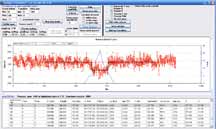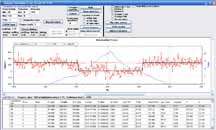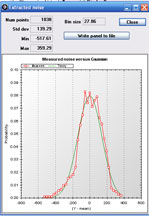The Simeisa Occultation
Dec 29/30, 2011
Another bright, convenient occultation which crossed the Bay Area and I'd hoped would get a good set of observations. Derek and I had tracks nearly on top of each other and so I told OccultWatcher software I'd observe from Locatelli Meadow, which was just inside the southern predicted limit and gave me 48% nominal odds of seeing the occultation. But when the day came, we had strong cirrus clouds and predictions of heavier clouds further north. Ted was visiting family in Seattle, and Chris was still in SoCal for Xmas. So it was me, Derek, and Walt Morgan. I got a late start from home, and this week am upping my swimming to be sure to better last year's totals - so I had to get in 4,000 yds each day this week at the pool. That came first, and I then headed towards the observatory where Duncan and Gene awaited. Gene wanted to get a series of dark frames so he could do model fitting to different temperatures, allowing synthetic darks to be determined. As I left the gym, fog was already coming in, and as I drove to the Cabrillo offramp a couple miles later, fog was already streaming over the freeway. It was getting a little late to try and drive anywhere, and I thought that the odds that both Derek and I would get data to be low enough so as not to justify packing up the equipment and making a run to avoid the fog. As I arrived at the observatory, the fog was still a half mile away. Duncan and Gene were there, and I got them set up inside the dome, then drove to my office to print the charts and info sheet, then drove back. There was 90 minutes till the 7:15pm event and I debated again whether I should rush off to get farther from the fog.... and decided again to stay and hope the fog did not come in. A half hour before the event, fog came over the ridge and covered most of Cabrillo's campus, but not quite to the observatory. The cirrus clouds were thin and allowed me to see the 8th mag star near the target. Then, 20 minutes before the event, the cirrus cleared enough that I could see the target - 10.3 mag - itself, and it looked like I might get data after all.
I found that I could get a parfocal arrangement by using the 32mm 2 inch Erfle if I pulled it out of the diagonal sleeve so that it had just a millimeter of travel left, then it was parfocal with the PC164Cex2/Meade f/3.3 reducer/1.25" adapter chain. This is a much better arrangement than using the 22mm Nagler as I've been doing in the past. And too, if I put the "EIA" sticker on the video camera facing up, then the camcorder LCD screen is oriented the same as I see in the diagonal eyepiece when standing straight back of the scope. The rectangle of the LCD field of view is slightly smaller than the rectangle on the smallest of the Preston charts (the inner rectangle here).
The odds of an occultation were nominally 40%, I needed a south shift. But once again, I got lucky! It did indeed shift south, by roughly (likely) a half path width or so, and clouds were thin enough that even though the 30% waxing moon was only 3 degrees away from the target, I was able to see it well enough to get good data. The occultation happened exactly on schedule. A "Hat Trick" these past two months - Quadea, Tugela, and Simeisa all videorecorded at Cabrillo in the past 8 weeks.
I used 'anchor' on LiMovie on both guide and target stars, so that each centered themselves on each frame. The target circles luckily were still properly placed when the R happened, so the data is likely good. However, it seems that 'anchor' better follows the star when it disappears, while 'drift' follows better when there is any mis-tracking. 'Anchor' doesn't work as well if the star is unocculted and slowly drifting. The circles dance to stay on the star, but only to account for small movement, not drift. Typically, my scope does wander just a tad during an event. So my new thinking is that I should click 'drift' while the target is unocculted, then pause the LiMovie tracking and change to 'anchor' just before the D, and then after the R switch back to 'drift'. I did this for a second run through below. The light curve looks more symmetric.
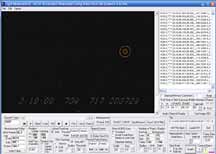
The LiMovie settings. The target is in the blue circle, and the yellow circles enclose the brighter 8th magnitude guide star at right. |
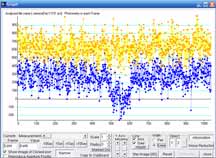
The LiMovie light curves. Note the strong correlation in the undulations in brightness between the two stars, lasting a second or two, throughout this 30 second record. Apparently this can happen when AC "rippling" if powered by AC current. However, the camcorder is always running off it's internal Li ion battery, and the PC164Cex2 was run off a separate 12V gel cell so no AC current was involved. It appears that the yellow tracking star variations lead the corresponding variations in the target star by a few frames, such as might occur with moving cirrus clouds. However, the dropdowns occur suspiciously regularly.
Tangra could probably do photometry by using the guide star as a comparison star and even out some of the undulations in cirrus-induced noise, although it would have an offset in time.
|
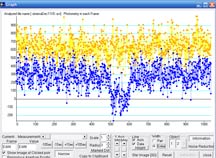
I did another LiMovie try. This time, I clicked 'drift' on the target so it would follow its slow drift better. Then, a second before the D, I paused it and switched to 'anchor', which better keeps it in place once the star disappears. It reappeared nicely inside the red circle and then, after another second or so, I paused again and switched back to 'drift' for the remainder of the video. The .csv file was saved at SimeisaDec11.csv |

OK, this photo's a cheat - I didn't get any people photos and so I stole this from the Tugela webpage of earlier in the month. BUT, we did have the same cast of characters (well, except Becky, who had to be.... ERASED (except you can still see her below the knees, under the table). Sorry, Becks! |
Occular reductions went fairly smoothly. I did get an 'unhandled exception error' on first processing, when the .csv file had one bad time. After I fixed that, it still came up with the same error, but next day when I tried again, it worked fine and gave me a final report. The light curve has the interesting two-level minimum. Perhaps it's noise, or perhaps it's changes in opacity or reflecting moonlight off the clouds
Then there is the apparent regular oscillation in level of the star, with about a 1 second period. Tony George thinks I should check to see if I'm getting varying voltage out of the gel cell powering the video camera. In this context, Walt Morgan last week tested this possibility, as I asked him if camera sensitivity varied significantly with battery power voltage. He used a high voltage, and low voltage to power the PC 164Cex2 and saw no difference in the sensitivity that he could detect.
Second Data Reduction
Following comments from Tony George, in LiMovie I slaved the positioning of the target circle to that of the brighter guide star. Then output the new file SimeisaDec11new.csv. I'm now thinking that this light curve is less reliable, as the photometry circles around the target did not center each frame, and this is perhaps why the D looks so gradual now. I'm thinking that as long as one can see that the circles are there at the right spot at the moment of the R, then letting guide star and target star circles center independently will be best. Anyway, here is the results...
The second Occular analysis is below. However, try as I might, I always get an "unhandled exception error" after clicking the "calculate FOM" and waiting for 100 trials on finding the D and R to complete. The unhandled exception error box is here . I have only Occular open, so the .csv file is not open by any other program (e.g. Excel).
Third Analysis
This time, I'm analyzing the LiMovie record which uses 'drift' till the D, 'anchor' till past the R, then back to 'drift'. The circles follow both stars well, and the light curve looks better than the other analyses, with a more sharply defined D and a more consistent bottom to the occultation. I kept getting an 'unhandled exception error' when it finished calculating the max FOM. Eventually, I rebooted the computer, with no other applications running, and this time the 'unhandled exception' didn't happen. I redid again, this time with Dreamweaver and with Photoshop CS2 both running and again no exception error. Gremlins in my machine??
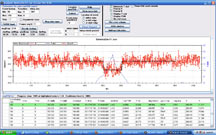
The entire light curve
|
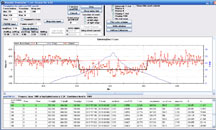
Zoomed in on just the occultation period
|
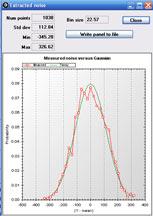
Error distribution still looks pretty Gaussian
|
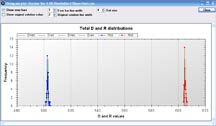
The histogram of D and R solutions |

Final report
|
The results look good. Now, the last issue is why is there a ~1 second sine wave in the target star data? I checked the output of the gel cell 12V battery used to power the Kiwi and the video camera. With no load, it read 13.38 VDC and held constant. When put under load (Kiwi and video camera), the voltage dropped to 13.18 volts and slowly dropped so that after a few minutes, it read 13.05 volts, but there was no pulsing, it was a steady decay. This doesn't sound like the source of the issue. I don't see these oscillations in my other occultations in the past 2 months (Tugela, Quedea) which were powered in the same way with the same equipment. Very strange.
Other Observers
The rest of the asteroid occultation hunters lost their battles with the weather, unfortunately. Derek had thick fog and could barely see the moon. Walt in Pleasanton had it only a little better, clouds just too thick to see more than one or two stars and not enough to make a positive ID of the field or the target. Apparently no other attempts - farther east the path headed north into areas w/o observers and with pretty cold and snowy weather this night.
Here's my Excel report to IOTA




